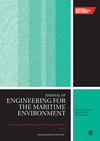Investigation of acoustic radiation from a sphere vibrating on the free surface of a finite depth water using a boundary element method
IF 1.5
4区 工程技术
Q3 ENGINEERING, MARINE
Proceedings of the Institution of Mechanical Engineers, Part M: Journal of Engineering for the Maritime Environment
Pub Date : 2023-10-31
DOI:10.1177/14750902231205349
引用次数: 0
Abstract
In this study, a boundary element method (BEM) is applied to investigate acoustic radiation from a sphere vibrating in pulsating mode on the free surface of finite or infinite depth water. Effect of the free surface is introduced by employing a half-space Green’s function. A modified version of the Helmholtz integral equation (HIE) is used to calculate acoustic radiation from the sphere vibrating in pulsating mode on the free surface. Free-terms of the HIE are calculated using two different forms of integrals and “dummy” boundary elements. Moreover, to simulate finite depth fluid medium, a chain image-source method is used to derive a waveguide Green’s function. To demonstrate applicability of the method presented, calculated acoustic pressures are compared with those by finite element method (FEM) and analytical calculations. Additionally, the effects of submergence depth and vibration frequency on acoustic radiation are investigated for infinitely deep water together with those of water depth and field point distance on acoustic radiation for finite water depth medium. The calculations show that there is a good agreement between BEM, FEM and analytical solutions. Also, it is observed that field point distance significantly affects the convergence behavior of waveguide Green’s function. Furthermore, it is noted that submergence depth, domain depth and vibration frequency have pronounce influence on radiated pressure amplitude and pressure field pattern.用边界元法研究在有限深度的自由水面上振动的球体声辐射
本文采用边界元法研究了有限或无限深自由水面上以脉动方式振动的球的声辐射问题。利用半空间格林函数引入了自由曲面的作用。利用改进的亥姆霍兹积分方程(HIE)计算了球在自由表面上以脉动方式振动时的声辐射。利用两种不同形式的积分和“虚拟”边界元计算HIE的自由项。此外,为了模拟有限深度流体介质,采用链像源法推导了波导格林函数。为了证明该方法的适用性,将计算得到的声压与有限元法和解析计算得到的声压进行了比较。此外,还研究了无限深水条件下潜水深度和振动频率对声辐射的影响,以及有限水深条件下水深和场点距离对声辐射的影响。计算结果表明,边界元法、有限元法与解析解吻合较好。此外,还观察到场点距离对波导格林函数的收敛行为有显著影响。此外,潜水深度、区域深度和振动频率对辐射压力幅值和压力场分布有显著影响。
本文章由计算机程序翻译,如有差异,请以英文原文为准。
求助全文
约1分钟内获得全文
求助全文
来源期刊

CiteScore
3.90
自引率
11.10%
发文量
77
审稿时长
>12 weeks
期刊介绍:
The Journal of Engineering for the Maritime Environment is concerned with the design, production and operation of engineering artefacts for the maritime environment. The journal straddles the traditional boundaries of naval architecture, marine engineering, offshore/ocean engineering, coastal engineering and port engineering.
 求助内容:
求助内容: 应助结果提醒方式:
应助结果提醒方式:


